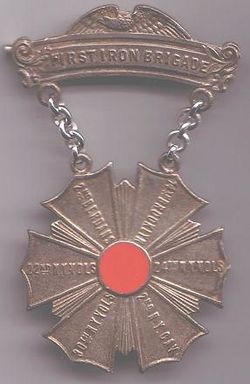Eastern Iron Brigade facts for kids
Quick facts for kids Eastern Iron Brigade |
|
|---|---|

This medal shows the "Eastern Iron Brigade," also called the "Iron Brigade of the East." It was a group of soldiers in the Union Army during the American Civil War. The red circle on the medal shows their connection to the 1st Division, I Corps, and that they were the first "Iron Brigade" formed.
|
|
| Active | 1861-1863 |
| Country | |
| Allegiance | |
| Branch | |
| Type | infantry |
| Size | Five regiments:
22nd New York Volunteer Infantry Regiment 24th New York Volunteer Infantry Regiment 30th New York Volunteer Infantry Regiment 14th Regiment New York State Militia (14th Brooklyn Chasseurs) 2nd United States Volunteer Sharpshooter Regiment |
| Nickname(s) | Iron Brigade of the East, First Iron Brigade |
| Engagements | American Civil War |
| Commanders | |
| Notable commanders |
General John P. Hatch Brig. Gen. Christopher C. Augur |
The Eastern Iron Brigade was a group of soldiers, called an infantry brigade. They fought for the Union Army during the American Civil War. It was also known as the Iron Brigade of the East or the First Iron Brigade. For most of its time, it was known as the 1st Brigade, 1st Division, I Corps.
Important leaders of this brigade included General John P. Hatch and General Walter Phelps Jr.. The brigade was known for being very reliable in battle. It earned a strong reputation, even after it was disbanded later in the war. This happened because the brigade suffered many casualties, meaning a lot of its soldiers were killed or wounded.
Contents
How the Eastern Iron Brigade Started
The Eastern Iron Brigade was made up of five main groups of soldiers, called regiments. These were the 22nd New York, 24th New York, 30th New York, 14th Regiment (New York State Militia), and 2nd U.S. Sharpshooters.
During some missions near Fredericksburg, Virginia, two cavalry (horseback soldier) regiments joined them temporarily. These were the 2nd New York Cavalry Regiment and the 6th New York Cavalry. However, these cavalry groups later returned to their usual divisions.
The brigade got its famous nickname, "Iron Brigade," in 1862. This happened during a campaign led by Brig. Gen. Christopher C. Augur. After a long march, another general, Marsena R. Patrick, told Augur: "Your men must be made of iron to make such marches." The soldiers loved this comment and adopted the name. They were first called the "Iron Brigade," and later the "Eastern Iron Brigade" to avoid confusion with another group.
The name "Iron Brigade" was first given to this group after a tough march on April 15, 1862. This was the First Brigade, First Division, First Army Corps. It included the Second United States Sharpshooters, and the 22nd, 24th, 30th, and 84th New York Volunteers. The 84th New York was also known as the "Fighting Fourteenth."
A historian named Colonel Fox noted that it was strange for two brigades in the same division to have similar nicknames. But he confirmed that Hatch's Brigade was the original "Iron Brigade."
The original Iron Brigade, which included the 14th Brooklyn, lost more soldiers in one battle (the Second Manassas) than the British Light Brigade did in the famous Battle of Balaklava. The British Light Brigade's bravery was written about in a famous poem.
The soldiers of the Iron Brigade were very proud of their nickname. Some regiments even added "Iron Brigade" to their flags, which they carried into battle. For example, the flag of the 24th New York Regiment was displayed in 1865. It proudly showed the words: "24th Regiment, Iron Brigade, 1st Division, 1st Army Corps."
Fighting at South Mountain
The Iron Brigade fought very hard at the Battle of South Mountain. Colonel Walter Phelps Jr. had just taken command of the brigade on the day of this battle. Around 4 PM, the Iron Brigade was ordered to move up the mountain. Their job was to help General Patrick's brigade attack the Confederate soldiers on top of the hill.
They first went in as skirmishers, which means they spread out to fight in small groups. Then, they waited behind a fence for the order to move forward.
Colonel Phelps ordered his men to advance. General Hatch also rode through the lines, urging them forward. The soldiers charged with a cheer, firing their weapons. They drove the enemy away from their position behind the fence after a short but fierce fight. Then, the Iron Brigade took over that position.
Colonel Phelps later explained that his brigade was ordered to move up the mountain. They had to force the Confederates away from a fence and take their spot.
Phelps praised his soldiers for their excellent behavior. Even though the enemy was strongly positioned behind a fence and seemed to have more soldiers, they could not stop the Iron Brigade's strong attack. The fight at the fence was desperate. Many enemy soldiers were very close, but the bravery of the officers and men helped them drive the enemy away. They also captured some prisoners. The brigade lost many soldiers at this spot, more than anywhere else in the battle.
After forcing the enemy back, Phelps moved his line forward about 5 rods (about 27 yards). There, his men found some cover from a small hill. He noticed that the right side of his line went past the enemy's left side. So, he ordered the Fourteenth Brooklyn to move their right side forward. This allowed them to fire along the enemy's lines, which caused a lot of damage. The brigade held its position until another brigade took over.
The brigade's performance at the Battle of South Mountain was highly praised. Phelps also mentioned the brave actions of Lieutenant Cranford and Lieutenant Schenck, who were his aides. They often had to carry orders through heavy enemy fire. Their courage was especially notable because their usual duties did not require them to be on the battlefield at that time.
The Iron Brigade suffered about 25 percent losses at South Mountain. Out of 400 officers and enlisted men, 20 enlisted men were killed. Four officers and 63 enlisted men were wounded, and 8 were missing. In total, 95 soldiers were casualties.
After Fredericksburg
After a successful campaign, the brigade mostly did scouting and information-gathering work for the Army of the Potomac. Before the Battle of Gettysburg in July 1863, the original 1st Brigade, 1st Division, I Corps was broken up. All its regiments were moved to other brigades or sent home.
Sergeant Major James Mero Matthews of the 2nd U.S. Sharpshooters wrote in his journal about being transferred out of the First Iron Brigade. He noted that Colonel Phelps gave a heartfelt speech. Then, the brigade said goodbye to the Sharpshooters by shaking hands.
Around that time, another brigade, led by Brig. Gen. Solomon Meredith, also became known as the "Iron Brigade." This group had received a lot of attention since the Battle of South Mountain in September 1862. This second group was then renamed the 1st Brigade, 1st Division, I Corps.
This led to many arguments between the soldiers of the two brigades. Regiments like the 14th Brooklyn continued to insist that they were part of the original First Iron Brigade. The men of the 14th Brooklyn never called their group the "Eastern Iron Brigade." They felt they were the first and true original Iron Brigade of the East.
Weapons Used
Records from around the time of the Fredericksburg campaign show that the regiments had different types of rifles. They used "Springfield Rifled Muskets," models 1855 and 1861, which were .58 caliber. They also used 1853 Enfield Rifled Muskets, which were .58 and .577 caliber.
During the Battle of Chancellorsville, the units mostly used "Springfield Rifled Muskets." These were the .58 caliber models. By the start of the Overland campaign, they still mainly used Springfield Rifled Muskets, with only a few Enfield rifles left.
Historical Records of the First Iron Brigade
Over time, much about the First Iron Brigade was forgotten. It was almost lost to history. However, between 1998 and 2008, many records and accounts of the actual First Iron Brigade came to light. Here are some examples from war records and reports:
One statement says that in June, a regiment became part of the 1st brigade, 1st division, 3rd corps. In September 1862, this same brigade and division became part of the 1st corps, Army of the Potomac. This brigade was known as the Iron Brigade even before the famous "Iron Brigade of the West" was formed.
Captain Austin W. Holden of the 24th New York State Infantry wrote a poem called "The Old Iron Brigade":
"The Old Iron Brigade"
From the camp and its now peaceful revels,
The bugles will soon call us forth,
The "Thirtieth" and "Red Legged Devils",
"Twenty-second" and the brave "Twenty-fourth."
To terror each heart is a stranger,
Tis cowards alone are afraid,
Then on to the front line of danger,
With the gallant old "Iron Brigade."
A report from William Fox of the 107th New York states: "The brigade that was composed of the 22nd New York, 24th New York, 30th New York, 14th Regiment [New York State Militia], and 2nd U.S. Sharpshooters was the first to be called the 'Iron Brigade' because of its brave fighting at South Mountain and Antietam."
The New York Herald newspaper reported on June 2, 1863: "The old 'Iron Brigade' is no more. One by one its regiments have passed through Washington to their homes... The Twenty-fourth and Thirtieth left several days since and their departure and reception at home have already been chronicled. The Twenty-second passed through Washington last night and the Fourteenth remains alone..."
Captain Levi Beardsley wrote a letter when the 24th New York's Company I was leaving service: "In common with the gallant '24th,' you have earned distinction, and are well worthy the title of 'braves of the Iron Brigade.' You cheerfully offered your lives upon the altar of our country, and have been consecrated in the blood of fallen comrades. You have gained a name and a reputation of incalculable value, and should be enshrined in the memory of a grateful commonwealth."
Other "Iron Brigades"
There have been other military groups known as "Iron Brigades":
- Another brigade in the Army of the Potomac was from western states. It became famously known as the "Iron Brigade of the West." This group was made up of units from Indiana, Wisconsin, and Michigan. They were also called "The Black Hats."
- Historians have found two other brigades that were called "The Iron Brigade" by their members or others:
- The 3rd Brigade, 1st Division, III Corps (including regiments from Maine, Michigan, and New York).
- Reno's Brigade from the North Carolina expedition (including regiments from Massachusetts, Pennsylvania, and New York).
- Today, the Second Brigade of the U.S. Army's First Armored Division has been known as the "Iron Brigade" since 1985.
- The current U.S. Army Third Brigade of the Fourth Infantry Division is also called the "Iron Brigade."
Confederate Army – Shelby's Iron Brigade
Shelby's Iron Brigade was a Confederate cavalry (horseback soldiers) brigade. It was also known as the "Missouri Iron Brigade." This Confederate Iron Brigade was part of a division led by Brig. Gen. Joseph O. "Jo" Shelby. They fought in Maj. Gen. Sterling Price's Missouri Expedition in 1864.


